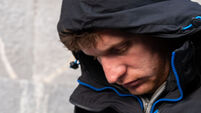Cigarette butts the main scourge as litter levels soar

Last year, almost 12% of urban areas and just over 20.5% of rural areas were unpolluted.
File image: Gareth Fuller/PA Wire
Passengers and pedestrians remain the main culprits for littering with cigarette butts, chewing gum, food and sweet wrappers causing the most problems, according to a new survey which has reported an overall rise in littering year-on-year.
Discarded cigarette butts actually account for more than half of all litter, with chewing gum adding another 10%, the Department of Environment-commissioned report said.
The National Litter Pollution Monitoring System, spearheaded by the department as well as local authorities and engineering consultants Tobins, found that as well as a rise in litter pollution overall, unpolluted or litter-free areas decreased almost 3% from a year previously to 17.3% in 2019.
It said:
- Cigarette related rubbish (53.9%) continues to constitute the highest percentage of litter in the locations surveyed – comprised mainly of cigarette ends which make up 50.9% of all litter items nationally.
- Packaging litter (14.9%) is the second-largest component. Bottle caps, bottles, drink lids, drink cups, beverage cans, and bags and wrappers, are the main litter items in this category.
- Food-related litter (12.3%) is the third-largest category. Chewing gum is the single largest litter component in the food-related litter category, and the second-largest component nationally, comprising 10.6% of all litter recorded.
- Sweet-related litter (9.4%) is the fourth-largest category of litter pollution. Sweet wrappers, made of plastic and foil, are the largest litter component.
Passing pedestrians were the main source of the problem, followed by passing motorists, with both groups discarding almost two-thirds of the litter. Retail outlets, people gathering, places of leisure and entertainment, and fast food outlets were also guilty of littering.
Fly-tipping and dumping was the cause of just under 2.5%, similar to bus stops, the report said.
In 2019, almost 12% of urban areas and just over 20.5% of rural areas were unpolluted. The percentage of slightly polluted areas in urban areas is 60%, and in rural areas is just under 63%.
The percentage of moderately polluted areas experienced in urban areas is over 25%, with 13.5% experienced in rural areas, the survey said.
In order to compile comprehensive data for the report, the Local Government Computer Services Board (LGCSB) developed a Litter Geographical Information System (GIS) software package to assist local authorities to map potential sources of litter and identify survey locations.
Local authorities determine the survey locations using maps produced by the GIS Software, the Department said.
Some 40% surveyed were so-called “high risk" locations, 40% were random potential litter generating areas chosen by the GIS Software, and 20% were based on local authority knowledge of litter pollution in the area.
Environment minister Eamon Ryan said that with packaging and food-related litter accounting for over a quarter of litter pollution, it is more important than ever that the actions proposed under the recently-announced Waste Action Plan for a Circular Economy are implemented.
“With passing motorists and pedestrians responsible for 64% of litter pollution between them, we need to reflect on our personal responsibilities, especially now in the midst of a global pandemic," he said.










